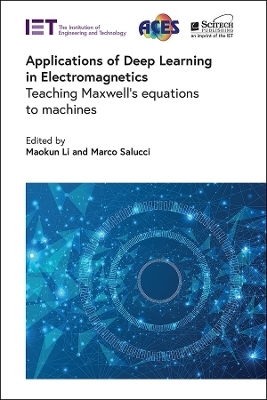
Applications of Deep Learning in Electromagnetics
Institution of Engineering and Technology (Verlag)
978-1-83953-589-5 (ISBN)
Deep learning has started to be applied to solving many electromagnetic problems, including the development of fast modelling solvers, accurate imaging algorithms, efficient design tools for antennas, as well as tools for wireless links/channels characterization. The contents of this book represent pioneer applications of deep learning techniques to electromagnetic engineering, where physical principles described by the Maxwell's equations dominate. With the development of deep learning techniques, improvement in learning capacity and generalization ability may allow machines to "learn" from properly collected data and "master" the physical laws in certain controlled boundary conditions. In the long run, a hybridization of fundamental physical principles with knowledge from training data could unleash numerous possibilities in electromagnetic theory and engineering that used to be impossible due to the limit of data information and ability of computation.
Electromagnetic applications of deep learning covered in the book include electromagnetic forward modeling, free-space inverse scattering, non-destructive testing and evaluation, subsurface imaging, biomedical imaging, direction of arrival estimation, remote sensing, digital satellite communications, imaging and gesture recognition, metamaterials and metasurfaces design, as well as microwave circuit modeling.
Applications of Deep Learning in Electromagnetics contains valuable information for researchers looking for new tools to solve Maxwell's equations, students of electromagnetic theory, and researchers in the field of deep learning with an interest in novel applications.
Maokun Li (senior member, IEEE) is an associate professor in the Department of Electronic Engineering at Tsinghua University, Beijing, China. He received his BS degree in electronic engineering from Tsinghua University, Beijing, China, in 2002, and his MS and PhD degrees in electrical engineering from University of Illinois at Urbana-Champaign in 2004 and 2007, respectively. After graduation, he worked in Schlumberger-Doll Research as a research scientist before he joined Tsinghua University in 2014. Marco Salucci (senior member, IEEE) received an MS degree in Telecommunication Engineering from the University of Trento, Italy, in 2011, and his PhD degree from the International Doctoral School in Information and Communication Technology of Trento in 2014. He was a postdoctoral researcher at CentraleSupélec, in Paris, France, and then at the Commissariat à l'Énergie Atomique et aux Énergies Alternatives (CEA), in France. He is currently an assistant professor at the Department of Civil, Environmental, and Mechanical Engineering (DICAM) at the University of Trento, and a Research Fellow of the ELEDIA Research Center. Dr Salucci is a member of the IEEE Antennas and Propagation Society and he was a member of the COST Action TU1208 "Civil Engineering Applications of Ground Penetrating Radar." He is the associate editor for communications and memberships of the IEEE Transactions on Antennas and Propagation. Moreover, he serves as an associate editor of the IEEE Transactions on Antennas and Propagation and of the IEEE Open Journal of Antennas and Propagation, and as a reviewer for different international journals including IEEE Transactions on Antennas and Propagation, IEEE Transactions on Microwave Theory and Techniques, IEEE Journal on Multiscale and Multiphysics Computational Techniques, and IET Microwaves, Antennas & Propagation. His research activities are mainly concerned with inverse scattering, biomedical and GPR microwave imaging techniques, antenna synthesis, and computational electromagnetics with focus on system-by-design methodologies integrating optimization techniques and artificial intelligence for real-world applications.
Chapter 1: An introduction to deep learning for electromagnetics
Chapter 2: Deep learning techniques for electromagnetic forward modeling
Chapter 3: Deep learning techniques for free-space inverse scattering
Chapter 4: Deep learning techniques for non-destructive testing and evaluation
Chapter 5: Deep learning techniques for subsurface imaging
Chapter 6: Deep learning techniques for biomedical imaging
Chapter 7: Deep learning techniques for direction of arrival estimation
Chapter 8: Deep learning techniques for remote sensing
Chapter 9: Deep learning techniques for digital satellite communications
Chapter 10: Deep learning techniques for imaging and gesture recognition
Chapter 11: Deep learning techniques for metamaterials and metasurfaces design
Chapter 12: Deep learning techniques for microwave circuit modeling
Chapter 13: Concluding remarks, open challenges, and future trends
| Erscheinungsdatum | 16.05.2023 |
|---|---|
| Reihe/Serie | Electromagnetic Waves |
| Verlagsort | Stevenage |
| Sprache | englisch |
| Maße | 156 x 234 mm |
| Themenwelt | Naturwissenschaften ► Physik / Astronomie ► Elektrodynamik |
| ISBN-10 | 1-83953-589-X / 183953589X |
| ISBN-13 | 978-1-83953-589-5 / 9781839535895 |
| Zustand | Neuware |
| Haben Sie eine Frage zum Produkt? |
aus dem Bereich


